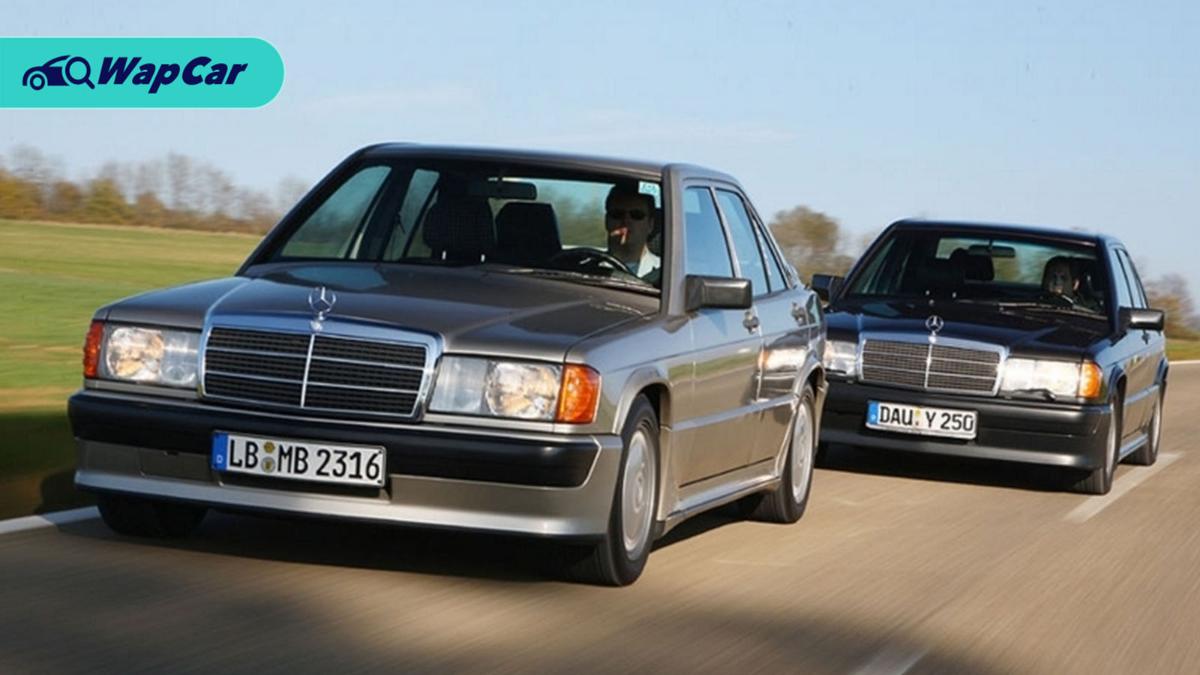![The original Baby Benz – The history of the Mercedes-Benz W201 01]()
When the Mercedes-Benz W201 made its debut in December 1982, its looks were far from unique. However, the entry-level model that slotted below the E-Class, S-Class, and SL-Class in Mercedes-Benz’s line-up has become a truly sought-after model and a symbol for the German brand’s future endeavour.
![The original Baby Benz – The history of the Mercedes-Benz W201 02]()
The timeless shape and design were penned by Bruno Sacco. Its sharp lines were reminiscent of its siblings, giving it a very distinct, Teutonic Mercedes-Benz look. This W201 was also known as the Baby Benz by fans for being the smallest Mercedes-Benz at the time.
![The original Baby Benz – The history of the Mercedes-Benz W201 01]()
To keep in line with Mercedes-Benz’s naming scheme in the nineties, the W202 that replaced the W201 was given the name C-Class which stood for “compact class”. However, the recipe for Mercedes-Benz’s compact executive sedan was already set with the launch of the W201 in terms of safety, handling, and reliability.
Advanced aerodynamics
![The original Baby Benz – The history of the Mercedes-Benz W201 02]()
In order to get better fuel mileage, Mercedes-Benz has enhanced the aerodynamics of the car in terms of design and used high-strength steel to reduce overall weight. Because of this, the W201 only weighed 1,180 kg without compromising on safety.
![The original Baby Benz – The history of the Mercedes-Benz W201 03]()
In this aspect, the W201 used a forked-member structure on the front which was shared with the W126 S-Class model at the time. Basically it meant that both the smaller W201 and the flagship W126 both meet similar safety requirements at the time.
Multi-link independent rear suspension
![The original Baby Benz – The history of the Mercedes-Benz W201 04]()
The Mercedes-Benz W201 used a revolutionary modern chassis design. It introduced the 5-link rear suspension which provides optimum wheel control. This technology also helps to improve steering precision and ensured well-balanced comfort no matter the conditions.
![The original Baby Benz – The history of the Mercedes-Benz W201 05]()
It wasn’t just the rear that got innovative tech, but so was the front. The front axle was equipped with shock absorber struts with anti-dive control, giving the car excellent stability on the straights.
State-of-the-art production facility
![The original Baby Benz – The history of the Mercedes-Benz W201 06]()
The W201 began assembly in Sindelfingen in 1982 and later on, in Bremen in 1983. The plants had to be modernised in a very long and expensive process in order to produce the then-new compact executive Mercedes-Benz.
High-tech powertrains
![The original Baby Benz – The history of the Mercedes-Benz W201 07]()
Early in production, the W201 was available in two variants, the 190 and the 190 E. The 190 was powered by a 2.0-litre 4-cylinder petrol engine that delivered 90 PS. The 190 E produced more power at 122 PS thanks to the mechanical electronically-controlled Bosch K/KE-Jetronic gasoline injection system. This helps to give the 190 E achieve a top speed of 195 km/h.
![The original Baby Benz – The history of the Mercedes-Benz W201 08]()
To describe the Baby Benz’s top speed in the 190 E, the 1982 brochure for the W201 calls it “Mercedes-style spiritedness”. Guess it combined the comfort and speed delivered by the W201.
The diesel that whispers
![The original Baby Benz – The history of the Mercedes-Benz W201 09]()
A year later, in 1983, the diesel-powered 190 D was launched. It was powered by a modern 2.0-liter 4-cylinder diesel engine. This engine helped paved the way for modern diesel technology in Mercedes-Benz passenger cars and was known as the “whisper diesel". The engine was twice as quiet as other diesel powerplants at the time, hence its nickname.
![The original Baby Benz – The history of the Mercedes-Benz W201 10]()
This was achieved by the installation of soundproofing materials around the engine bay. While it is somewhat a standard in cars today, the 190 D was the first production car in the world to have that feature nearly 40 years ago.
The diesel engine had a respectable power output of 72 PS which in turn gave low fuel consumption. Over the ten years the model was in production, a total of 452,806 units of the 190 D were built.
![The original Baby Benz – The history of the Mercedes-Benz W201 11]()
In 1984, the 190 E 2.3-16 “Cosworth” made its debut as the flagship model of the W201. As the name of the variant implied, the 190E Cosworth was powered by a 2.3-litre engine with 16 valves. The only other visual addition apart from the badge was a wing-type rear spoiler.
![The original Baby Benz – The history of the Mercedes-Benz W201 12]()
The engine was boosted up to 185 PS and top speed was 230 km/h. The sport compact sedan was able to accelerate to 100 km/h from rest in just 7.5 seconds.
![The original Baby Benz – The history of the Mercedes-Benz W201 13]()
Before the hot-version of the W201 was launched however, 3 prototypes were brought over to Nardo, Italy where they had set several world long-distance records over 25,000 km and 50,000 km with an average speed of 250 km/h. These results were just a litmus test to show the potential of the W201’s subsequent career in motorsports.
![The original Baby Benz – The history of the Mercedes-Benz W201 14]()
In 1985, Mercedes-Benz introduced a 2.5-litre 5-cylinder diesel engine to the 190 D. It produced 90 PS but provided the same impressive fuel economy as the outgoing 2.0-litre diesel. It had a top speed of 174 km/h.
Improved 6-cylinder engines
![The original Baby Benz – The history of the Mercedes-Benz W201 15]()
In 1986, Mercedes-Benz installed an inline 6-cylinder with a 2.6-litre displacement to the 190 E. Combined with a 5-speed manual transmission, the engine produced 166 PS. 0-100 km/h took 8.2 seconds and the 190 E 2.6 had a top speed of 215 km/h. To make it visually distinguishable, Mercedes-Benz added twin tailpipes and a more steeply angled front apron with wider louvres.
High-performance diesel engine
![The original Baby Benz – The history of the Mercedes-Benz W201 16]()
A turbo was added to the 190 D’s diesel engine in 1987. Power output for the oil burner is boosted to 122 PS and the updated 190 D was able to sprint to 100 km/h from rest in 11.5 seconds. Top speed was also increased to 192 km/h.
An evolutionary update
![The original Baby Benz – The history of the Mercedes-Benz W201 17]()
The year 1988 was a significant year for the W201 as the 1 millionth W201 had rolled off the assembly line in Bremen in March that year. It was also restyled to give a more modern look and was unveiled at the 1988 Paris Motor Show.
![The original Baby Benz – The history of the Mercedes-Benz W201 18]()
Larger front and rear bumpers with new support elements and modified impact absorbers were introduced in this facelift W201 to help increase energy absorption in collisions. Even the new rear spoiler was designed to provide a more optimised airflow outflow to the car.
![The original Baby Benz – The history of the Mercedes-Benz W201 19]()
In the cabin, a more ergonomic and spacious design was introduced to give more knee and headroom to both front and rear occupants. Even the seats were improved to give more comfort.
![The original Baby Benz – The history of the Mercedes-Benz W201 20]()
Then came the hotter W201, the 190 E 2.5-16 which replaced the 190 E 2.3-16. Even with a catalytic converter, the performance was top-notch, producing 195 PS.
![The original Baby Benz – The history of the Mercedes-Benz W201 21]()
If that’s not hot enough, there’s the Evolution I with 205 PS of power from the regular 2.5-16. It made its debut at the 1989 Geneva Auto Show and looked absolutely wild with a new rear spoiler and wider wheel arches.
![The original Baby Benz – The history of the Mercedes-Benz W201 22]()
Then, there’s the even more bonkers Evolution II which was shown at the 1990 Geneva Auto Show which produced 235 PS and 245 Nm from the same 2.5-litre engine as the first Evolution.
![The original Baby Benz – The history of the Mercedes-Benz W201 23]()
What made this even crazier was the amount of body kit on the Evolution II – large adjustable rear wing, rear window spoiler, and Evolution II 17-inch alloy wheels. All 500 units were painted in “blauschwarz” blue/black metallic but 2 were painted in astral silver.
The DTM touring car legend
![The original Baby Benz – The history of the Mercedes-Benz W201 24]()
The Mercedes-Benz 190 E 2.5-16 became the basis for entering the Group A of the German Touring Car Championship (DTM). Because of this, Mercedes-Benz produced 500 units of the Evolution I and 502 units of Evolution II for homologation purposes.
![The original Baby Benz – The history of the Mercedes-Benz W201 25]()
Mercedes-Benz dominated the DTM by becoming manufacturer champions in 1991 and 1992. As a matter of fact, Mercedes-Benz did a double in 1992, winning both the manufacturer and driver’s championship with Klaus Ludwig at the wheel of a 190 E Evo II.
The final refinements
![The original Baby Benz – The history of the Mercedes-Benz W201 26]()
The W201 received final updates in 1991 with ABS standard across all variants. It ended production in 1993 and a total of 1,879,629 units have been produced since its debut in 1982.
![The original Baby Benz – The history of the Mercedes-Benz W201 27]()
The sales figures showed how successful the compact Mercedes-Benz was while keeping the brand’s stand as being a symbol of ultimate luxury. It had all the technological innovation in a compact package with performance to boot.
The W201 was truly ahead of its time and created a new segment for Mercedes-Benz, the affordable Benz but without the cost-cutting measures.
![The original Baby Benz – The history of the Mercedes-Benz W201 28]()




































